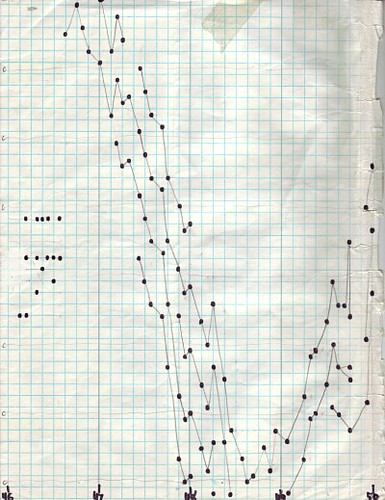
The pianist John Mark Harris has performed Xenakis` solo piano piece 'Evryali' and made a rather natty animated graph of the work. Here is how he explains it..
Evryali was composed in 1973 and premiered by its dedicatee Marie-Fran oise Bucquet that same year in New York. The title refers to the "Medusa, with head of writing snakes", as well as "the open sea". Both allusions have clear meanings upon hearing the piece.
Evryali is the first work composed from Xenakis' idea of "arboressences". First, the composer drew shapes on a computer screen that were later realized in traditional music notation. Some lines (or branches) appear alone, while other lines grow from them, branching off on their own. The branches often become intertwined with one another, and sometimes these groups of branches, like bushes, break off into other groups. The groups of notes undergo continuous transformation and growth, and these "arboressences" create moving, expanding, and rotating acoustic shapes.
Because the published score is so phenomenally complicated, I found it impossible to have any formal or dramatic image to work with when I first decided to interpret Evryali. I began to make a simple graph of sections of the piece, which eventually grew into a graph of the entire piece.
Evryali was composed without regard to the limitations of the human anatomy, as the branching often expands beyond the range of two human hands. In more than one instance, the branching has caused bushed to appear at the extreme right and left of the keyboard, yet there are also bushes in the center of the piano. The performer must obviously edit the score. The graph I made became a tool for determining what I would leave out. I have made an edition in which the integrity of individual branches and limbs are maintained as much as possible; sometimes this necessitates the felling of other entire limbs. With any method of editing Evryali, one is forced to delete as many as half the notes in a given passage.
The music that remains, after editing, is anatomically possible. Yet the performer is left with an undertaking that can not be thought of as reasonable. The relentless repetitive motions, wide leaps, and awkward streams of chords directly challenge the pianist's need for fluid fingers and free arms. The pianist runs the risk of gazing into Medusa and freezing solid. Brute force and physical endurance are not enough to solve the difficulty. Only through the same imagination that one finds the music "possible" can one find the answer to its realization.
As one can never view Medusa directly, without cheating in the manner of Perseus, one can never hear the piece performed exactly as composed. The audience is not granted a true image of Evryali, but must, like Perseus, experience only a reflection of the monstrosity.
The piece was also realised by Steve Layton, this time via midi, you can listen here. You can also look at midi screen shots and download Steve`s midi file, nice!.
Worth mentioning here, if you missed it in one of my previous posts, you can now get a piece of software based on Xenakis` UPIC program for your home PC/Mac, it`s called HighC and the basic version is free.
Via Metafilter.




1 comment:
This is one page of a graph I made of the entire piece. If you want to see a graph of the entire piece, which scrolls along during one of my performances of it (all this made possible by Tucker Dulin), go to http://alltheseworlds.org/evryali/
Post a Comment